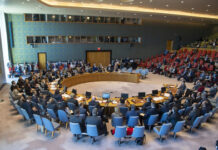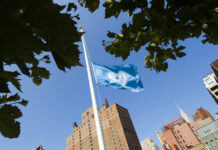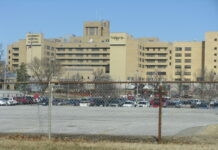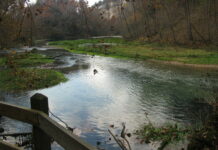Photo credit: DiasporaEngager (www.DiasporaEngager.com).
CDC Deployments to Assist Health Departments
On January 21, 2020, CDC activated its Emergency Operations Center to facilitate coordination for domestic and international COVID-19 response efforts (2); the same day, at the request of the Washington State Health Department, CDC deployed a team to Washington to support the health department’s epidemiologic investigation of the first U.S. case of COVID-19 in a traveler returning from China (3). On March 15, CDC established a dedicated COVID-19 response section to support state, tribal, local, and territorial health departments (4). CDC deployment data were analyzed to describe activities by deployed CDC teams in assisting state, tribal, local, and territorial health departments in the identification and implementation of measures to contain SARS-CoV-2 transmission (1). The CDC COVID-19 state, tribal, local, and territorial response section provides support to health departments by responding to inquiries, identifying and collaborating with CDC subject matter experts, and deploying CDC teams in response to receipt of official requests for assistance from health departments. Dedicated teams of CDC subject matter experts have participated in evaluating contact tracing efforts and have investigated COVID-19 epidemiology in counties with rapidly increasing numbers of cases and incidence (“hotspots”) to identify jurisdictions needing targeted support (5). Further, the CDC COVID-19 state, tribal, local, and territorial response section helps coordinate efforts between CDC, health departments, and subject matter experts across federal agencies and other organizations including the CDC Foundation, the National Association of County and City Health Officials, the Association of Public Health Laboratories, Association of State and Territorial Health Officials, and the Council of State and Territorial Epidemiologists.
The CDC COVID-19 state, tribal, local, and territorial response section coordinated deployment requirements with health departments and selected staff members with the necessary skills after an official request for assistance. CDC COVID-19 Response General Staff, Division of Emergency Operations, and Office of Safety, Security, and Asset Management ensured that all deployers were supported before, during, and after deployment, including providing briefings before and after deployments; coordinating risk assessments, medical clearance, and travel and lodging arrangements; and issuing deployment-essential equipment, including personal protective equipment to prevent SARS-CoV-2 transmission during field deployments. Deployer feedback received during postdeployment debriefings were used to improve deployment processes and procedures for subsequent deployments.
During January 21–July 25, in response to official requests for assistance, 1,009 CDC staff members participated in 208 CDC deployment teams to assist 55 state, tribal, local, and territorial health departments with COVID-19 emergency public health response activities (Figure 1)*; some persons deployed multiple times. Trends in the deployment of CDC teams generally followed trends in national COVID-19 case counts. The number of deployed field teams per week increased during January–April and declined during May–June; however, from mid-June to July 25, the number of deployed teams increased (Figure 2).
Among 168 (81%) teams that had completed deployment by July 25, the mean deployment duration was 20 days (range 1–89 days) (Table). Among the remaining 40 teams deployed as of July 25, duration of deployment ranged from 1–146 days; several teams were providing sustained epidemiologic support. Among the 208 teams deployed following official requests for assistance, 178 (85%) provided assistance to state health departments, 12 (6%) to tribal health departments, 10 (5%) to local health departments, and eight (4%) to territorial health departments.
Because state, tribal, local, and territorial health departments could request assistance with a range of public health activities, deployed team members possessed diverse technical skills and expertise, and a single team could provide technical assistance in multiple areas. The top five areas of technical assistance provided by deployed teams were the following: 1) epidemiologic support (144 teams; 69%), 2) infection prevention and control in health care settings (77; 37%), 3) health communications (37; 18%), 4) community mitigation (36; 17%), and 5) occupational safety and health (31; 15%). Some deployed CDC teams provided subject matter expertise in investigation and mitigation of SARS-CoV-2 transmission in high-risk congregate settings, which often include populations at increased risk for severe COVID-19–associated outcomes, such as long-term care facilities (53 teams; 26%), food processing facilities (24 teams; 12%), correctional facilities (12; 6%), and settings that provide services to persons experiencing homelessness (10; 5%). Knowledge, attitudes, and practices surveys helped involve community members in identifying barriers to services, difficulties experienced when trying to follow prevention actions, and preferred communication channels. Aligned with CDC’s COVID-19 health equity strategy,† some teams focused attention on supporting local officials in describing health equity issues, such as describing SARS-CoV-2 transmission among disproportionately affected racial and ethnic minority populations, essential frontline workers, persons experiencing homelessness, as well as through a place-based focus, such as responding to COVID-19 outbreaks in rural communities and frontier areas. Twenty-eight (13%) teams deployed specifically to assist in addressing SARS-CoV-2 transmission among racial and ethnic minority groups, including supporting tribal health departments and those focused on COVID-19 among migrant farm workers.
Because CDC staff members could deploy more than once, the 1,009 CDC staff member deployments included 726 individual CDC staff members. Overall, 516 (71%) staff members deployed once, 156 (21%) deployed twice, and 54 (8%) deployed three or more times. Among the 1,009 individual deployments, the top four primary deployer roles were epidemiologic support (422; 42%), leadership (137; 14%), infection prevention and control (88; 9%), and clinical support (65; 6%); additional primary deployer roles included data science, laboratory science, health communications and community outreach, occupational safety and health, coordination, veterinary science, and behavioral science. Deployed CDC staff members helped increase local capacity by assisting with developing data collection instruments, conducting trainings on COVID-19 case investigation and contact tracing, and providing support to improve public health information technology systems.
Source of original article: Centers for Disease Control and Prevention (CDC) / MMWR (Journal) (tools.cdc.gov).
The content of this article does not necessarily reflect the views or opinion of Global Diaspora News (www.GlobalDiasporaNews.com).
To submit your press release: (https://www.GlobalDiasporaNews.com/pr).
To advertise on Global Diaspora News: (www.GlobalDiasporaNews.com/ads).
Sign up to Global Diaspora News newsletter (https://www.GlobalDiasporaNews.com/newsletter/) to start receiving updates and opportunities directly in your email inbox for free.




























